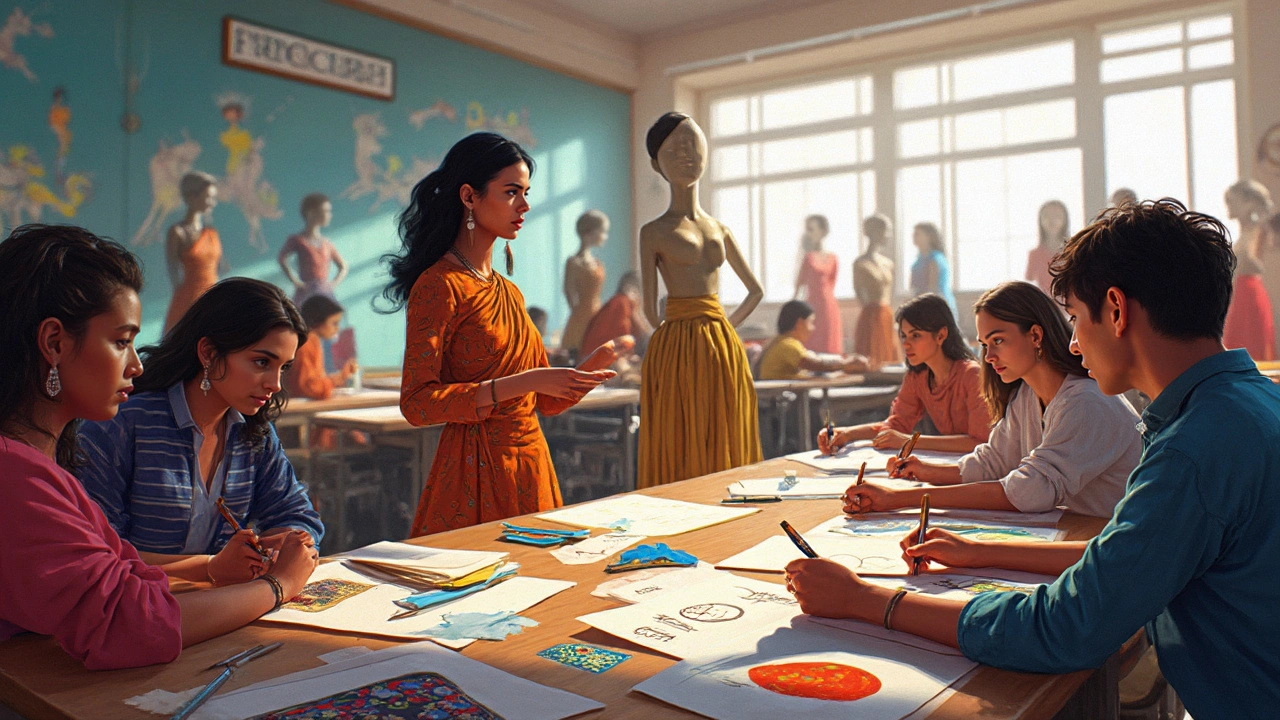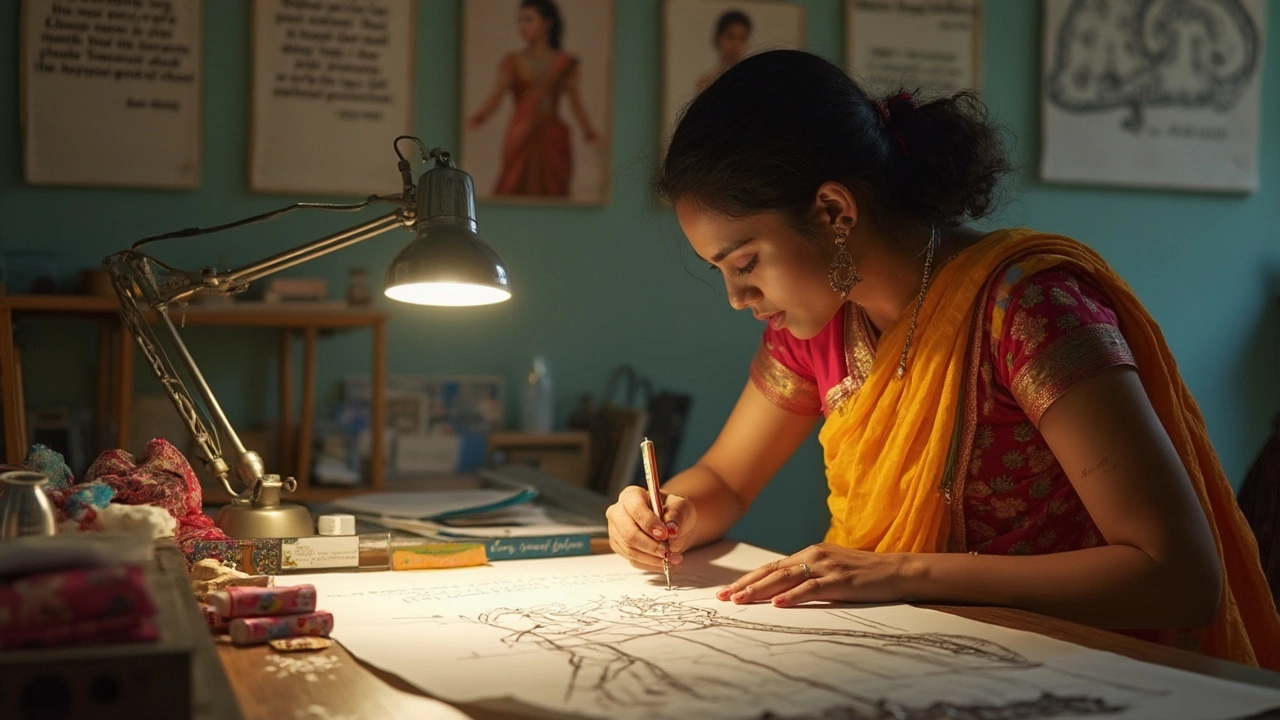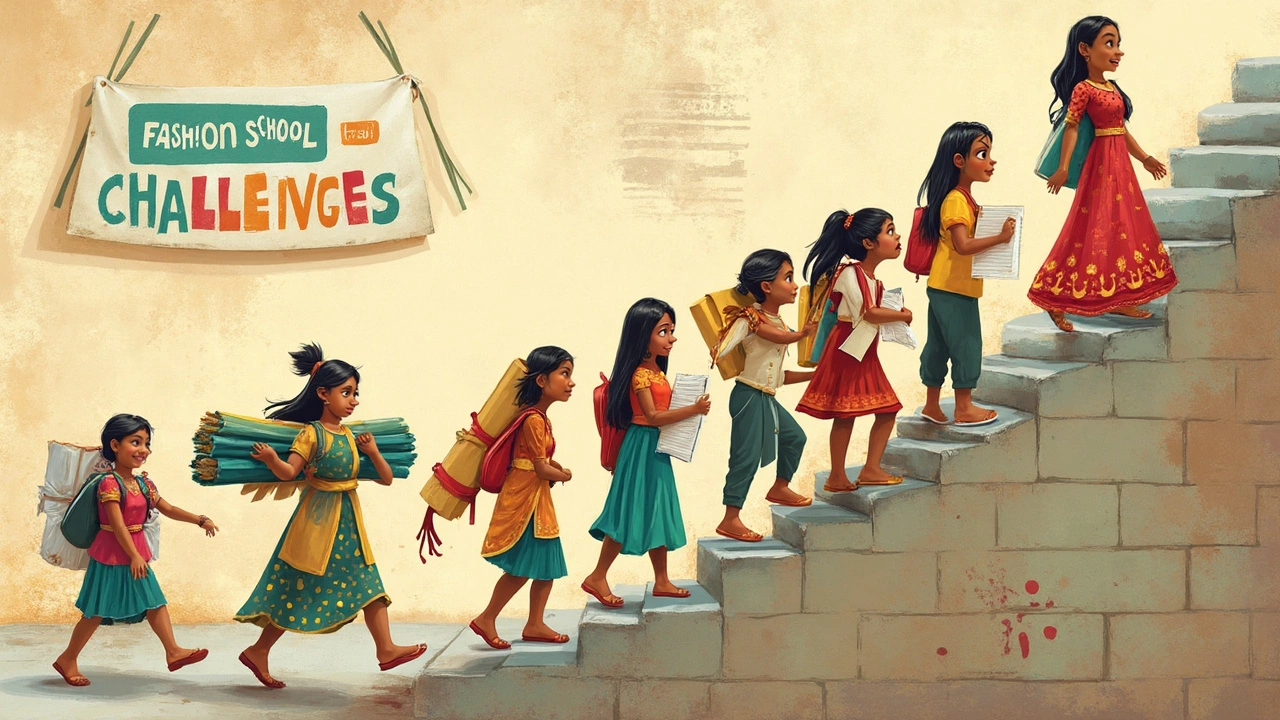
You might think fashion designing is all about sketching cool outfits or scrolling through Pinterest for inspiration. There's way more to it. The course quickly gets real. You're looking at a mix of strict deadlines, tons of projects, and even technical stuff like pattern making and textile science. Forget those glamorous runway shows you see on Instagram—fashion school is serious work.
If you’ve never touched a sewing machine or you struggle with time management, you’ll feel the pressure early on. Most courses throw you into all kinds of hands-on assignments, and you’ll probably pull your first all-nighter before the end of the first semester. But, there’s an upside: You get to see your designs come to life, which is a pretty wild experience after all those late nights.
Fast fact—a 2023 survey from a top Mumbai design school showed that 87% of students found the first year way harder than they expected, mainly because of how much technical knowledge and teamwork was required.
- What Is Fashion Designing Really Like?
- Skills You Need (Not Just Drawing!)
- Common Challenges and How to Beat Them
- Tips to Survive and Thrive in Fashion School
Skills You Need (Not Just Drawing!)
If you think you need to be a pro at drawing to ace a fashion designing course, relax a bit—that's only part of it. Designers do sketch a lot, but your toolbox needs way more.
First off, sewing isn’t just an old-school grandma hobby. It's a make-or-break skill. You must know how to work a sewing machine, understand stitches, and play around with fabrics. Fashion schools test this from day one. Also, you'll spend a ton of time learning about different textiles—their strengths, weaknesses, and even how they react to temperature and washing.
Next, say hello to computers. Most students are surprised by how much digital work is involved. Courses teach you software like Adobe Illustrator and Photoshop so you can create digital designs and patterns. If tech scares you, you’re definitely in for a learning curve, but it’s totally doable once you get some practice.
But wait, there’s more: fashion designing goes deep into research and trend analysis. You’ll need to read industry reports, follow big designers online, and break down what works (and what bombs) each season. Being good at research and open-minded about new trends really helps.
Good communication skills matter here. From getting feedback on your portfolio to presenting your ideas in class, you have to explain your thought process, defend your choices, and sometimes sell your concept to a pretty tough crowd.
Here’s a snapshot of the skills most schools expect:
| Skill | Why It Matters |
|---|---|
| Drawing & Sketching | Turning ideas into clear visuals |
| Sewing & Construction | Actually making what you’ve designed |
| Computer Design (CAD) | Modern designing and technical layouts |
| Textile Knowledge | Choosing the right fabric and finish |
| Trend Research | Spotting what’s next in fashion |
| Time Management | Juggling multiple projects and deadlines |
| Communication | Pitching ideas to peers and teachers |
Pro tip: If you’re already a multitasker or you love solving real-life puzzles, you’ll actually enjoy the problem-solving parts—like fitting designs to odd body types or fixing last-minute disasters right before a project is due.

Common Challenges and How to Beat Them
Fashion designing courses throw a lot at you, and not just cool assignments. Most folks hit a wall when they realize making clothes isn’t as dreamy as it looks online. Here’s what usually trips people up—and how to deal with it.
- Time Crunch: Deadlines pile up fast. You’ll often have multiple projects due in the same week, plus theory exams. Procrastinating is a trap. Build a simple calendar, even on your phone, and break down big tasks into smaller chunks. The earlier you start, the less you panic at the end.
- Technical Struggles: Sewing, pattern-making, and fabric science don’t come naturally to everyone. If you’ve never cut fabric before, it’s easy to mess up. Watch online video tutorials or team up with a classmate who’s good at the technical stuff. Colleges like NIFT run free practice sessions; use them.
- Creative Blocks: Sometimes nothing you sketch looks good. Fashion students complain about losing inspiration in the middle of big projects. Walk away for a bit, scroll through international designer portfolios, ask professors for feedback, or just swap ideas over coffee. One weird suggestion can spark something new.
- Criticism Burnout: Getting feedback on your work is tough, especially when it’s blunt. In a 2023 student survey, 72% said negative reviews knocked their confidence. Here’s the thing—nobody’s work is perfect, not even the top designers. Take notes, learn from it, and move on. What matters is the improvement, not just praise.
- Material Costs: Good fabrics and quality supplies add up fast. Some semesters, students spend ₹6000–₹9000 just on materials. Buddy up and buy in bulk, or check if your college offers discounts. Lots of juniors reuse scraps from seniors—it’s totally normal.
Here’s a quick look at what recent students found the toughest and how they handled it:
| Challenge | % of Students Affected | Popular Solution |
|---|---|---|
| Time Management | 81% | Calendar Apps, Peer Groups |
| Technical Skills | 78% | Extra Practice, Online Videos |
| Creative Block | 65% | Peer Feedback, New Inspirations |
| Material Costs | 56% | Buy in Groups, Seek Discounts |
| Criticism Handling | 72% | Mentor Support, Focus on Progress |
The truth? Every fashion designing student hits at least a couple of these bumps. Knowing they’re normal—and having a game plan—makes a massive difference. Borrow advice from upper-year students, keep an open mind, and you’ll get through the tricky parts faster.

Tips to Survive and Thrive in Fashion School
If you're dreaming of making it big in the fashion world, surviving and thriving in a fashion designing course is where it all kicks off. There's no magic formula, but some survival tips have turned newbies into pros. Here’s what you really need to know.
- Get Good at Time Management: Juggling assignments, projects, and sometimes even internships is normal. Make a habit of using planners or digital calendars. Blocking out regular hours for design, research, and practice helps way more than you’d think.
- Be Open to Feedback: Your first draft won’t be perfect, and that’s fine. Professors and even classmates will critique your work. Instead of taking it personally, listen up and use it. Some top students say they improved the most from brutal but honest feedback sessions.
- Don’t Skip the Technical Stuff: Sketching is cool, but sewing, understanding textiles, and knowing how fabric reacts when worn matter just as much. Fashion houses in India once said that 60% of their new interns struggled most with the technical parts. Don’t fall into that trap—practice and ask for extra help if needed.
- Build Real Networks: Whether it's collaborating on group assignments or volunteering backstage at student fashion shows, people you meet in school often end up opening career doors. One fashion grad from NIFT Delhi landed her first job through a connection she made at a campus event.
- Balance Creativity and Practicality: Big ideas are great, but every collection needs to be wearable and make business sense. Try entering college contests or pitch your designs to friends and family for honest, practical opinions.
Want to see how students manage their workload? Check out this comparison of hours spent per week on the main tasks, based on a 2023 survey at Pearl Academy:
| Task | Average Hours per Week |
|---|---|
| Sketching & Design | 10 |
| Technical Work (sewing, pattern-making) | 12 |
| Research & Concept Development | 8 |
| Group Projects | 6 |
| Fashion Theory/Business Classes | 4 |
Last bit of advice—get comfortable with failing a few times. Everyone flops at some point. The students who bounce back fast and keep improving are the ones who actually make a mark.
